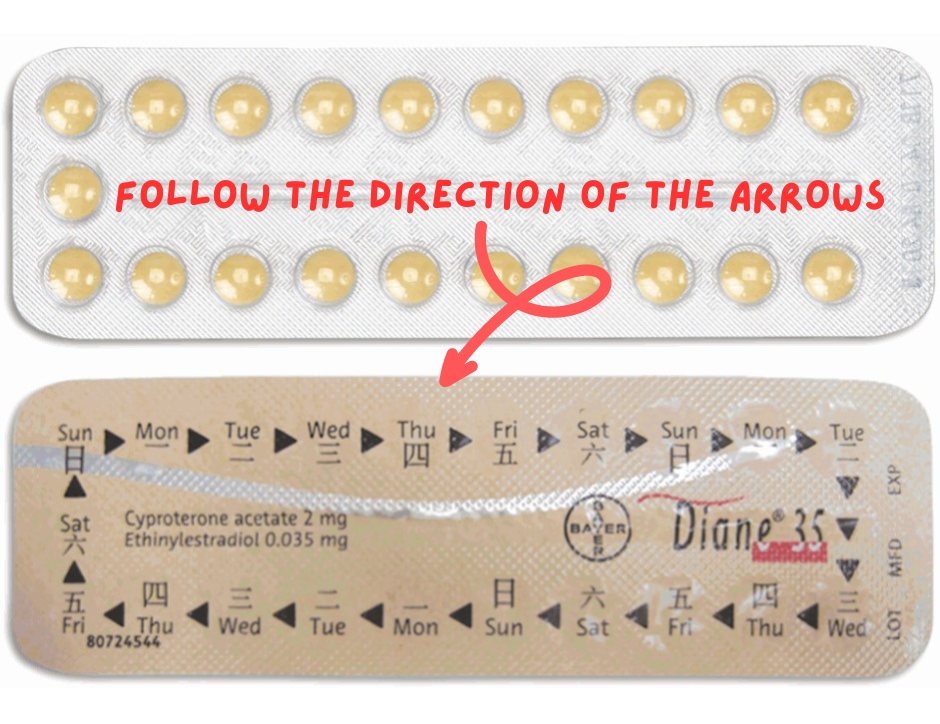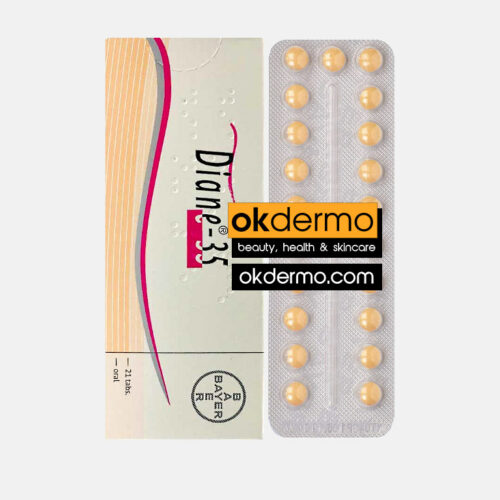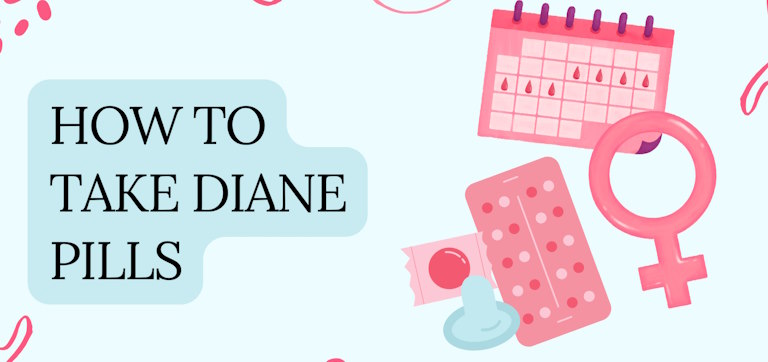The Ultimate Guide on How to Take Diane Pills Effectively
Table of Contents
As you may recall from our earlier blog, Diane is a combined oral contraceptive pill containing synthetic versions of two hormones: estrogen and progestogen. Beyond its primary role in contraception, Diane offers a spectrum of benefits, from alleviating acne and excessive hair growth to regulating menstrual irregularities.
Diane 35 boasts a remarkable success rate when taken correctly, with a mere 1% failure rate per year. However, ensuring its efficacy requires adherence to proper usage as irregular intake of DIANE-35 could lead to intermenstrual bleeding and could reduce the therapeutic and contraceptive reliability.
Therefore, to reap its full advantages, it’s essential to understand how to take Diane pills effectively while avoiding common mistakes during administration.
How to Take Diane Pills – A Simplified Guide
DIANE-35 is a medication that needs to be taken regularly to achieve its therapeutic and contraceptive benefits. Here’s a simpler, step-by-step guide to help you understand how to use it effectively.
Step 1: Stop Prior Hormonal Contraception
Before you start using DIANE-35, make sure to stop any other hormonal contraceptives you’ve been taking. The dosage regimen of DIANE-35 is similar to most combined oral contraceptives, implying that the same administration rules apply.
Step 2: Daily Consumption
Take one tablet every day, following the sequence specified on the package containing 21 pills. It’s best to take the tablet at the same time each day and you can take it with liquid if needed. This process should go on for 21 consecutive days without a break. [Some packs may contain 28 pills, with the last 7 being placebo pills.]

Step 3: Start the Next Pack
Commence the next pack after a 7-day pill-free break, starting the new pack on the eighth day.
Step 4: Expect Withdrawal Bleeding
Withdrawal bleeding, which is similar to a menstrual period, usually begins during the pill-free interval, typically 2-3 days after taking the last active pill. It may not have finished before you start the next pack.
Step 5: Initiate DIANE-35 Based on Prior Contraceptive Usage
Your prior contraceptive usage dictates when you should start taking DIANE-35.
If you haven’t used hormonal contraceptives in the past month, start on the first day of your natural cycle (the first day of your menstrual bleeding). Use an additional barrier method for the first 14 days.
If you’re switching from a combined hormonal contraceptive, start DIANE-35 the day after the last hormone-containing tablet of your previous contraceptive. If a vaginal ring or transdermal patch has been used, start using DIANE-35 on the day of removal of the last ring or patch of a cycle pack.
If you’re switching from a progestogen-only-method, you may switch any day from the minipill, from an implant or the IUS on the day of its removal, or from an injectable when the next injection would be due. However, during the first cycle, an additional barrier method is recommended for the first 14 days of tablet-taking.
If you’ve had a first trimester abortion, you can start immediately. Use an additional barrier method for the first 14 days.
If you’re breastfeeding or after delivery or second trimester abortion, Start taking DIANE-35 21 to 28 days after delivery or second-trimester abortion. Use an extra barrier method for the first 14 days of the cycle. If you’ve had intercourse, confirm you’re not pregnant before starting DIANE-35 or wait for your first menstrual period.
-

Diane 35® Tablets
Cyproterone 2mg + Ethinyl Estradiol 0.035mg
Brand name: Alisma, Ancea, Axira, Bellgyn, Bellune, Chloe, Claudia, Diclin, Feminac
Size: 21 Tablets
USD $27.00 Add to cart -

Femilon® Tablets
Ethinyl Estradiol 0.02mg + Desogestrel 0.15mg
Size: 1 Strip of 21 Tablets
Brand name: Viorele, Azurette, Bekyree, Caziant, Cyred, Juleber, Kalliga, Mircette
USD $19.00 Add to cart -

Novelon® Tablets
Ethinyl Estradiol 0.03mg + Desogestrel 0.15mg
Size: 1 Stip of 21 Tablets
Brand name: Apri, Caziant, Cesia, Cyclessa, Kariva, Reclipsen, Solia, Velivet, Desogen
USD $18.00 Add to cart
What to Do If You Miss a Tablet
If you happen to miss taking your contraceptive tablet, don’t panic. The steps you take next depend on how late you are in taking it.
If you realize you’re less than 12 hours late in taking your tablet, take it as soon as you remember. Then, continue with the rest of your tablets at your usual scheduled time. This minor delay won’t compromise your contraceptive protection.
However, if you’re more than 12 hours late, your contraceptive protection might be affected. In such a scenario, it’s crucial to adhere to two rules:
- Consistency is Key: Never go without taking your tablets for more than 7 consecutive days. This consistent intake is essential for maintaining effective contraceptive protection.
- Reinforce with Barrier Protection: To compensate for the missed tablet and to bolster your contraceptive measures, use a barrier method such as condoms for the next 7 days. This additional precaution helps mitigate the risk of unintended pregnancy.
Moreover, if you’ve missed tablets and notice no withdrawal bleed during the hormone-free phase of your cycle, it’s prudent to consider the possibility of pregnancy and seek further guidance.
If You Experience Bleeding or Gastrointestinal Disturbances
Experiencing unexpected bleeding or gastrointestinal issues while on DIANE-35 can be concerning, but knowing how to respond can help alleviate worries.

Intermenstrual Bleeding: Should you encounter light bleeding while taking the beige tablets, it’s generally not cause for alarm. Continuing with your scheduled tablets should resolve the issue. However, if the bleeding becomes heavy or persistent, seeking a thorough examination from your healthcare provider is advisable to rule out any underlying concerns.
Absence of Bleeding During the Starter Section: If you find yourself not experiencing any bleeding during the initial phase of taking the tablets, it’s important to discontinue use and seek guidance from your doctor. This deviation from the expected pattern warrants further evaluation to ensure your health and well-being are prioritized.
Gastrointestinal Disturbances: Severe gastrointestinal disturbances can interfere with the complete absorption of the contraceptive components. In such cases, additional contraceptive measures may be necessary to maintain effectiveness. If you happen to vomit within 3-4 hours after taking a beige tablet, it’s advised to follow the protocol for missed tablets outlined earlier.
Length of use
The duration of using DIANE-35 hinges on the severity of your androgenization symptoms and their therapeutic response. Typically, the regimen spans several months, with an expected onset of symptom alleviation no sooner than three months. Notably, Dermatological conditions like acne and seborrhea often exhibit earlier response compared to hirsutism.
Nonetheless, your healthcare provider will regularly reassess the necessity of continued treatment. Should symptoms recur weeks or months post-discontinuation of tablet intake, a re-initiation of DIANE-35 therapy may be advised.
However, if you resume DIANE-35 after a pill-free interval exceeding four weeks, be mindful of the heightened risk of venous thromboembolism.
Common Mistakes to Avoid When Taking Diane 35
While Diane 35 is an effective contraceptive pill when taken correctly, there are common mistakes that can compromise its efficacy. Understanding these mistakes can help users avoid potential pitfalls and ensure the medication’s effectiveness:
Inconsistent Timing:
One of the most common mistakes is not taking Diane 35 at the same time every day. Irregular timing can disrupt hormone levels, leading to breakthrough bleeding and reduced contraceptive effectiveness. Users should establish a daily routine for pill intake to maintain consistency.
Skipping Pills:
Skipping pills, either intentionally or accidentally, can increase the risk of unintended pregnancy. Missing even one pill can disrupt hormone levels and compromise contraceptive protection. It’s essential to take Diane 35 every day as prescribed, without skipping doses.
Not Starting on the Right Day:
Initiating Diane 35 on the wrong day of the menstrual cycle can affect its effectiveness. It should ideally be started on the first day of menstruation to ensure immediate contraceptive coverage. Starting late in the cycle may necessitate additional contraception during the first pill pack.
Improper Handling of Missed Doses:
Many users may not know how to properly handle missed pills. Taking the missed pill too late or not using additional contraception when necessary, can increase the risk of unintended pregnancy. It’s crucial to follow specific guidelines for managing missed doses outlined by healthcare providers.
Prolonged Use Without Medical Supervision:
Some individuals may continue taking Diane 35 for extended periods without consulting a healthcare professional. Prolonged use without medical supervision can increase the risk of side effects and complications. It’s essential to follow up with a gynecologist regularly to assess the need for continued use.
Ignoring Warning Signs:
Certain symptoms, such as persistent breakthrough bleeding, mood changes, or severe headaches, should not be ignored. These could indicate underlying issues or intolerance to the medication. Users should promptly report any unusual symptoms to their healthcare provider for evaluation and guidance.
Not Using Backup Contraception When Necessary:
During certain situations, such as missed pills or when taking medications that may interact with Diane 35, additional contraception may be necessary to ensure continuous protection against pregnancy. Failing to use backup contraception when needed can increase the risk of unintended pregnancy.
Avoiding these common mistakes is crucial for maximizing the effectiveness of Diane 35 and minimizing the risk of unintended pregnancy and other complications. Users should adhere to prescribed guidelines, seek medical advice when needed, and stay vigilant for any warning signs or changes in their health while taking the medication.
Contraindications
Preparations that combine estrogen and progestogen should not be administered if any of the following conditions are present. If these conditions arise during use, cease using the product immediately:
- Allergic reactions to the active ingredients or any additives.
- Current or previous occurrences of venous thrombosis (such as deep vein thrombosis or pulmonary embolism).
- Current or previous occurrences of arterial thrombosis (e.g., heart attack) or related symptoms (e.g., angina or transient ischemic attack).
- History of stroke.
- History of migraines accompanied by focal neurological symptoms.
- Presence of severe or multiple risk factors for venous or arterial thrombosis, including:
- Inherited or acquired predisposition to venous or arterial thrombosis, such as activated protein C resistance, antithrombin-III deficiency, protein C deficiency, protein S deficiency, and antiphospholipid antibodies (e.g., anticardiolipin antibodies or lupus anticoagulant).
- Severe liver disease until liver function returns to normal.
- Use of direct-acting antiviral (DAA) medications containing ombitasvir, paritaprevir, dasabuvir, or their combinations (refer to section 4.5).
- Current or previous history of liver tumours (benign or malignant).
- Known or suspected hormone-influenced cancers (e.g., genital or breast cancers).
- Unexplained vaginal bleeding.
- Concurrent use with another hormonal contraceptive.
- Known or suspected pregnancy.
Note – DIANE-35 is not intended for use in males.
Conclusion
In conclusion, taking Diane pills involves adherence to a structured regimen tailored to individual needs and health considerations. By following the prescribed dosage, timing, and routine, you can optimize the therapeutic efficacy of Diane pills while effectively managing hormonal imbalances under medical supervision.
References
- Bachmann G, Sulak P. Combined oral contraceptives: pharmacology, efficacy, and safety. In: Hatcher RA, Trussell J, Nelson AL, et al., editors. Contraceptive Technology. 21st revised ed. New York, NY: Ayer Company Publishers; 2018. p. 265–334.
- Committee on Practice Bulletins-Gynecology. ACOG Practice Bulletin No. 206: Use of Hormonal Contraception in Women with Coexisting Medical Conditions. Obstet Gynecol. 2019;133(4):e128-e150.
- Faculty of Sexual & Reproductive Healthcare Clinical Effectiveness Unit. UK Medical Eligibility Criteria for Contraceptive Use (UKMEC 2016). Faculty of Sexual & Reproductive Healthcare; 2016. Available from: https://www.fsrh.org/standards-and-guidance/uk-medical-eligibility-criteria-for-contraceptive-use-ukmec/
- National Institute for Health and Care Excellence (NICE). Contraception – combined hormonal methods. NICE Clinical Knowledge Summaries. 2021. Available from: https://cks.nice.org.uk/topics/contraception-combined-hormonal-methods/
- World Health Organization. Medical eligibility criteria for contraceptive use. 5th ed. Geneva: World Health Organization; 2015. Available from: https://www.who.int/publications/i/item/9789241549158
- Dinger J, Bardenheuer K, Heinemann K. Cardiovascular and general safety of a 24-day regimen of drospirenone-containing combined oral contraceptives: final results from the International Active Surveillance Study of Women Taking Oral Contraceptives. Contraception. 2014;89(4):253–63.
- Royal College of Obstetricians and Gynaecologists (RCOG). Combined Hormonal Contraception. RCOG; 2019. Available from: https://www.rcog.org.uk/globalassets/documents/guidelines/combined-hormonal-contraception.pdf
- World Health Organization. Selected practice recommendations for contraceptive use. Geneva: World Health Organization; 2016. Available from: https://apps.who.int/iris/bitstream/handle/10665/252267/9789241565400-eng.pdf
Post by:
Dr.Marcella Jiovanni
Health and Beauty Expert
“Marcella Jiovanni actively promotes the importance of maintaining healthy skin, she envisions the future of dermatology as moving away from pure medical, pharmacological dermatology and flowing more toward a holistic approach to wellness and skincare.”

















